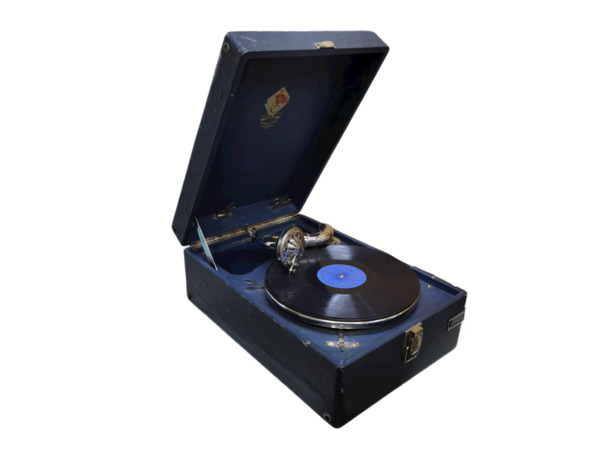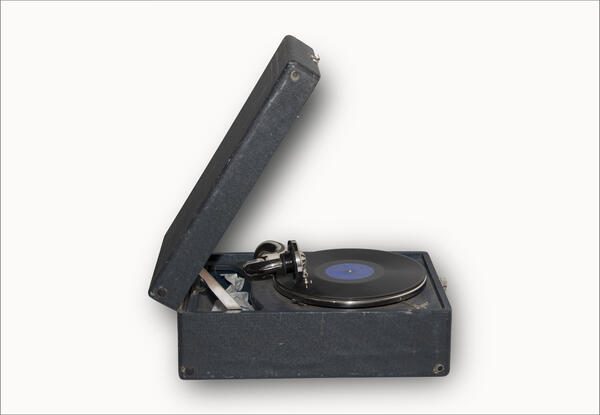A gramophone is a device for the reproduction of sound. Its earlier version known as a phonograph was invented by Charles Cros and Thomas Edison in 1877. Later, discs replaced cylinders as a recording medium.
The gramophone was patented by Emile Berliner on September 26, 1887. Initially, records were made of hard rubber, a material obtained by vulcanizing natural rubber, and later of shellac, a natural resin. The modernization of the gramophone in the early 20th century helped to offer a fairly high quality of sound. The production of such devices became a large-scale independent industry in the United States, Europe, and Russia.
In 1907, the Pathé company introduced its own version of a phonograph known in Russian as a “pathéphone”. Unlike the gramophone, it had a smaller amplifying horn that was built into the body. The device resembled a suitcase that could be closed and carried by using a special handle. The device from the museum’s collection was produced in 1937 and belongs to this type of portable gramophone.
The device was manufactured by Leningrad Gramophone Plant No. 1. The plant’s gramophones had a centrifugal speed controller. One winding of the spring was enough to play one side or, less often, both sides of a record at a speed of 78 revolutions per minute and around five minutes per side. It was necessary to exercise caution when winding the gramophone in order to avoid breaking the spring — the most important and scarce part of the device.
Leningrad Gramophone Plant No. 1 of the Soviet Union Trust of the Gramophone and Record Industry got its name in 1933 when it was placed under the authority of the People’s Commissariat of Heavy Industry of the USSR.
It was founded in 1928 based on the workshops of the Krasny Oktyabr Music Factory as an accordion and gramophone factory of the Music Association of the Supreme Board of the National Economy of the RSFSR. Between 1931 and 1933 it was known as Portable Gramophone Factory No. 3.
After the liquidation of the trust, the factory was delegated to the People’s Commissariat of General Engineering of the USSR. On May 29, 1939, the People’s Commissariat ordered to rename the factory the State Union Leningrad Gramophone Plant. It was liquidated in September 1940.
The gramophone was patented by Emile Berliner on September 26, 1887. Initially, records were made of hard rubber, a material obtained by vulcanizing natural rubber, and later of shellac, a natural resin. The modernization of the gramophone in the early 20th century helped to offer a fairly high quality of sound. The production of such devices became a large-scale independent industry in the United States, Europe, and Russia.
In 1907, the Pathé company introduced its own version of a phonograph known in Russian as a “pathéphone”. Unlike the gramophone, it had a smaller amplifying horn that was built into the body. The device resembled a suitcase that could be closed and carried by using a special handle. The device from the museum’s collection was produced in 1937 and belongs to this type of portable gramophone.
The device was manufactured by Leningrad Gramophone Plant No. 1. The plant’s gramophones had a centrifugal speed controller. One winding of the spring was enough to play one side or, less often, both sides of a record at a speed of 78 revolutions per minute and around five minutes per side. It was necessary to exercise caution when winding the gramophone in order to avoid breaking the spring — the most important and scarce part of the device.
Leningrad Gramophone Plant No. 1 of the Soviet Union Trust of the Gramophone and Record Industry got its name in 1933 when it was placed under the authority of the People’s Commissariat of Heavy Industry of the USSR.
It was founded in 1928 based on the workshops of the Krasny Oktyabr Music Factory as an accordion and gramophone factory of the Music Association of the Supreme Board of the National Economy of the RSFSR. Between 1931 and 1933 it was known as Portable Gramophone Factory No. 3.
After the liquidation of the trust, the factory was delegated to the People’s Commissariat of General Engineering of the USSR. On May 29, 1939, the People’s Commissariat ordered to rename the factory the State Union Leningrad Gramophone Plant. It was liquidated in September 1940.






